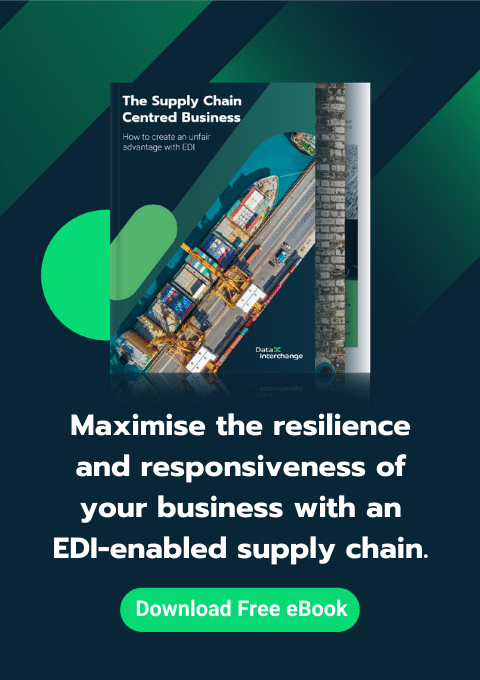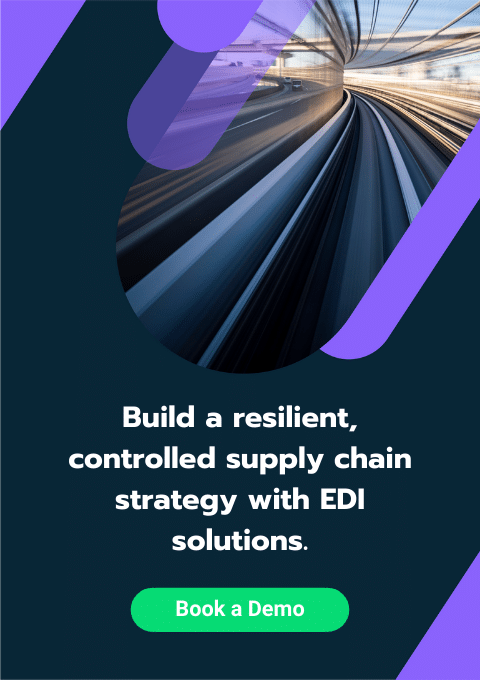Supplier Management Best Practices after COVID-19
The disruption and dislocation of early lockdown was a wake-up call for many businesses. Delays, shortages and general confusion were eventually overcome, but they demonstrated the fragility of complex and global supply chains — and the need for greater visibility and flexibility in the future. Ongoing remote working also needs to be taken into consideration, and so do the increased logistical demands of e-commerce and online deliveries.
As we move towards a post-pandemic world, supplier management best practice will need to address why things went wrong and how to develop reliable processes that are safeguarded against future supply chain shocks. For 65% of businesses, this means prioritising more efficient supplier management, followed by increased visibility and increased responsiveness.
EDI (Electronic Data Interchange) has historically provided the technical framework required to automate supply chain communication and improve supply chain performance and visibility. But up to 41% of companies still don’t use EDI — although the EDI market is expected to reach $5.9 billion (approx £4.25 billion) by 2025.
To a degree, EDI growth is the result of increased simplicity of EDI adoption. However, the same advances that are making EDI more accessible to small businesses have created more agile solutions for large organisations. At Data Interchange, we’ve spent over thirty-five years driving innovation within EDI. Here, we want to address how EDI is changing, and how next-level EDI solutions are poised to set new standards able to accommodate the demand for flexibility with complex supply chain management.
Additional resources: If you want to learn how the adoption of modern EDI can deliver a competitive advantage, check out our eBook — The Supply Chain Centred Business.
How supplier management needs to change
The main problems that supplier management encountered during the pandemic centred around concerns such as superficial supply chain understanding, single-source operations, and manual processes. These were by no means new problems, but COVID-19 provided the disruption required to make these challenges very clear. As attention beings to turn towards the post-pandemic future, many businesses are focusing on new key goals, such as:
- Increasing supply chain flexibility: The ability to onboard new suppliers quickly is critical to responding to regional and global disruptions without damaging output.
- Enhanced supply chain efficiency: By creating more efficient supply chains, it’s possible to re-invest within your operation — creating more efficiencies within a virtuous circle.
- Transparency and communication: Both flexibility and efficiency demand clear visibility for planning, straightforward communication to put plans into action — and the ability to plan long-term creates more robust outcomes that business can rely on.
Improved supplier relationship management (SRM) should drive these goals on a wider scale, ensuring not only more efficient supply chains in the present, but also providing future-proof supplier management solutions. Best practices especially worth paying attention to for the guarantee of reliable supply chain operations moving forward include:
- Sophisticated supply chain understanding: The better companies understand the complexity of their supply chains, the better placed they are to both track progress overall, and to recognise issues in the moment. This level of oversight was sadly lacking for 33% of companies going into the pandemic, leading to a domino effect of inefficiency that, moving forward, no supply chain can afford to repeat.
- Supply chain expansions: Single-source suppliers promise both ease of use and cost savings. However, as the pandemic proved, putting your eggs in one supply basket is a risk. Instead, true cost savings revolve around expanding supply chains for security should one partner fall.
- Digitisation of supply chain processes: Manual processes can damage smooth business operations. The key to minimising manual inputs and quality checking those that do occur is digitisation. Digitisation helps improve management, enhance visibility and simplify oversight. These in turn increase operational speed, facilitating Just-in-Time (JIT) manufacturing processes and reducing lead times.
What businesses need to improve
Simple solutions that can streamline analysis and planning, as well as accommodate change, will be pivotal going forward. Fundamentally, the outcomes necessary to improve supplier management best practices are the basics that EDI has sought to deliver since the 1960s. These include:
- Higher EDI adoption rates: By ensuring EDI is implemented throughout the supply chain you can create a coherent system that keeps errors to a minimum, provides increased levels of efficiency and improves visibility.
- Agile supplier onboarding: A fast and effective onboarding process is essential in order to avoid inefficiencies, wasted resources and foster collaborative supplier relationships.
Although traditional forms of EDI have improved supply chain visibility and optimisation, as well as largely removing manual processes from the transfer of business documents, there are still challenges to be overcome. Crucially, many internal systems haven’t been designed to handle the numerous data sets that are required to support EDI business processes. The result is a need for more flexibility and customisation, which can have subtle variations between suppliers and customers.
For many businesses, the challenges of custom development prevent the easy communication, enhanced supplier relationships and widespread onboarding that modern supply chains demand. What is needed are ways to overcome EDI implementation issues, simplify integration with supply chain partners and deliver holistic visibility over the supply chain.
The future of EDI
EDI needs to become more flexible, accessible and simple to match the demands of modern supply chains. However, there is a Catch 22 at the heart of most efforts to update EDI solutions. Accommodating the different EDI standards and requirements of different suppliers often necessitates a complicated and multi-dimensional system, which introduces more complexity while attempting to resolve complexity — undermining the point of the project.
At Data Interchange, the solution we’ve developed focuses directly on outcomes and resolves all of the complexity behind the scenes — a solution we call “EDI-as-a-Service”. This unites different types of EDI (e.g. Web EDI, EDI via VAN and point-to-point solutions) using a combination of cloud-based tools and managed services that are able to simplify access, guarantee compatibility and deliver seamless outcomes that are tailored to your exact needs — and the needs of your supply chain partners. The outcome is your ability to:
- Overcome complex EDI standards and protocols: EDI-as-a-Service provides access to EDI mapping tools, facilitating the translation of standards to simplify communication between supply chain partners. EDI experts can then step in where automated solutions aren’t enough.
- Provide ongoing support: Managed services provide flexible and cost-effective solutions for optimised supply chain management regardless of your EDI expertise, or that of your partners.
- Increase adoption throughout supply chains: By creating a system that is simpler for partners to engage with (using managed services and Web EDI tools), EDI-as-a-Service drives adoption and delivers a holistic view of the supply chain in the process.
- Automate EDI document exchanges in a single platform: Using cloud-based Value Added Networks (VAN), EDI-as-a-Service moves all your EDI documents to one place via a single connection, simplifying setup in the process.
From a supplier management standpoint, EDI-as-a-Service offers unparalleled visibility, making effective management easier than ever before and smoothing out historical supply chain kinks at long last.
Suggested reading: If you’re interested in reading further into EDI-as-a-Service and supply chains, take a look at our blog — How EDI-as-a-Service Changes Supply Chain Best Practices in 2021
Improved supply chain visibility is the key to success
A lack of visibility has always been an overriding supplier risk, facilitating the convoluted onboarding and lack of adaptability which resulted in numerous poor practices and prevented a supplier base that businesses could rely on during the pandemic. As such, supply chain visibility is imperative moving forward, opening the door for the best practices discussed and largely eliminating prevalent supply chain problems such as inefficiency. With global supply chains and remote working set to remain commonplace, supply chain visibility will be essential in providing:
- Resilient supplier management practices
- Effective inventory management
- The ability to foster understanding relationships
- The ability to foresee risks
EDI-as-a-Service is designed to deliver the visibility needed by increasing adoption rates and deploy advanced analytics tools within a single-source-of-truth platform. However, regardless of how you achieve this outcome, what’s needed is:
- Accessible, cloud-based information exchanges
- Reporting tools for forecasting, risk assessments, and strategic decisions
- Built-in flexibility for informed, fast onboarding
- Transparent communication channels
All of this stands to drive a resilient, controlled supplier performance management strategy moving forward, not only addressing the pain points that pandemic life has brought into sharp focus but ensuring a supply chain future that is built on strong foundations for easier oversight and maintenance.
How Data Interchange can help
As the disruption caused by the pandemic clears, being able to see every aspect of the supply chain is more important than ever, ensuring not only that companies can recover, but that they can approach future disruptions with a degree of flexibility that wasn’t in place previously.
Data Interchange’s EDI-as-a-Service offers precisely that benefit, taking the plus points of legacy EDI and giving them an overhaul which enables improved oversight, real-time communications, and the ability to adapt even before future storms hit. This ensures that, pandemic or not, your supply chains and the relationships within them are easier to foster, manage, retain, and even reinvest in down the line.
Supply chain storm-proofing doesn’t get much better than that, and you can enjoy almost immediate protection by booking a demo today.

















































































































